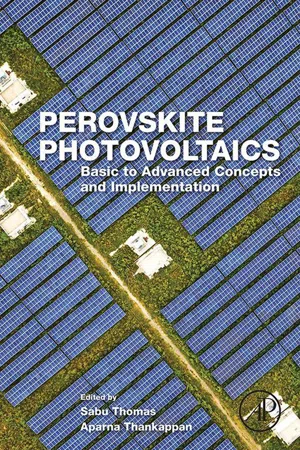
Perovskite Photovoltaics
Basic to Advanced Concepts and Implementation
- 518 pages
- English
- ePUB (mobile friendly)
- Available on iOS & Android
About This Book
Perovskite Photovoltaics: Basic to Advanced Concepts and Implementation examines the emergence of perovskite photovoltaics, associated challenges and opportunities, and how to achieve broader development. Consolidating developments in perovskite photovoltaics, including recent progress solar cells, this text also highlights advances and the research necessary for sustaining energy. Addressing different photovoltaics fields with tailored content for what makes perovskite solar cells suitable, and including commercialization examples of large-scale perovskite solar technology. The book also contains a detailed analysis of the implementation and economic viability of perovskite solar cells, highlighting what photovoltaic devices need to be generated by low cost, non-toxic, earth abundant materials using environmentally scalable processes.
This book is a valuable resource engineers, scientists and researchers, and all those who wish to broaden their knowledge on flexible perovskite solar cells.
- Includes contributions by leading solar cell academics, industrialists, researchers and institutions across the globe
- Addresses different photovoltaics fields with tailored content for what makes perovskite solar cells different
- Provides commercialization examples of large-scale perovskite solar technology, giving users detailed analysis on the implementation, technical challenges and economic viability of perovskite solar cells
Frequently asked questions
Information
Introduction
Why Perovskite and Perovskite Solar Cells?
Abstract
Keywords
1.1 Introduction
1.2 Present Photovoltaic Technologies

1.2.1 Wafer-Based Technology
1.2.1.1 Monocrystalline Silicon Solar Cell
1.2.1.2 Polycrystalline Silicon Solar Cell
1.2.2 Thin-Film Technology
Table of contents
- Cover image
- Title page
- Table of Contents
- Copyright
- List of Contributors
- Preface
- Chapter 1. Introduction: Why Perovskite and Perovskite Solar Cells?
- Chapter 2. Organometal Lead Halide Perovskite
- Chapter 3. Evolution of Perovskite Solar Cells
- Chapter 4. Perovskite Solar Cell Architectures
- Chapter 5. Hybrid Inorganic Organic Perovskites: A Low-Cost-Efficient Optoelectronic Material
- Chapter 6. Ion Migration in Hybrid Perovskites: Evolving Understanding of a Dynamic Phenomenon
- Chapter 7. Low-Dimensional Perovskites
- Chapter 8. Fabrication and Life Time of Perovskite Solar Cells
- Chapter 9. Hole Conductor–Free Perovskite Solar Cells
- Chapter 10. Heterojunction Perovskite Solar Cells
- Chapter 11. Flexible Perovskite Solar Cells
- Chapter 12. Fabrication of Semitransparent Perovskite Solar Cells
- Chapter 13. Commercialization of Large-Scale Perovskite Solar Energy Technology and Scaling-Up Issues
- Chapter 14. Perovskite Photovoltaics: Life Cycle Assessment
- Index